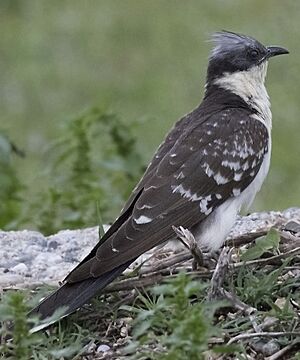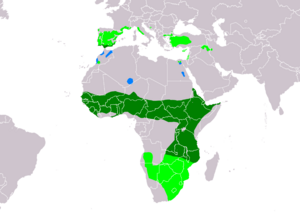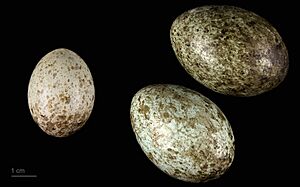Great spotted cuckoo facts for kids
Quick facts for kids Great spotted cuckoo |
|
|---|---|
 |
|
| Conservation status | |
| Scientific classification | |
| Genus: |
Clamator
|
| Species: |
glandarius
|
 |
|
| Range of C. glandarius Breeding Resident Non-breeding | |
| Synonyms | |
|
Cuculus glandarius Linnaeus, 1758 |
|
The great spotted cuckoo (Clamator glandarius) is a cool bird that belongs to the cuckoo family. This family also includes speedy roadrunners, anis, and coucals.
You can find these cuckoos across Africa and around the Mediterranean Sea. They are special because they are brood parasites. This means they lay their eggs in the nests of other birds, especially Eurasian magpies.
Contents
Where it Comes From: Its Name and Family
In 1747, a naturalist named George Edwards drew and described the great spotted cuckoo. He called it "The Great Spotted Cuckow." His drawing was based on a bird found in Gibraltar.
Later, in 1758, the famous Swedish naturalist Carl Linnaeus updated his book Systema Naturae. He gave the great spotted cuckoo its scientific name, Cuculus glandarius. This name combines the genus Cuculus with the species name glandarius.
Today, the great spotted cuckoo is placed in the genus Clamator. This name was given by a German naturalist, Johann Jakob Kaup, in 1829. The name Clamator comes from a Latin word meaning "shouter." The word glandarius means "of acorns" in Latin. This bird is the only one of its kind, meaning it has no different types or subspecies.
What it Looks Like and Eats
The great spotted cuckoo is a bit bigger than a common cuckoo. It is about 35 to 39 centimeters (14 to 15 inches) long. It looks even bigger because of its wide wings and long, thin tail.
Adult cuckoos have a grey back, a slender body, and strong legs. They have a grey cap on their head and grey wings. Their face and upper chest are yellowish, and their belly is white. Both male and female cuckoos look similar. Young cuckoos have blackish backs and caps. Their main wing feathers are a chestnut color. These birds fly in a way that reminds you of a magpie.
This cuckoo likes warm, open areas with trees. It eats insects, spiders, and small reptiles. It also enjoys eating hairy caterpillars. Many other birds do not like these caterpillars because they taste bad. The great spotted cuckoo makes a loud call that sounds like cher-cher-kri-kri.
How it Lives
Reproduction: How it Raises its Young

Unlike some other cuckoos, the great spotted cuckoo mother or her chick does not push the host bird's eggs out of the nest. However, the young magpies in the nest often do not survive. This is because they cannot get enough food when competing with the cuckoo chick.
Interestingly, great spotted cuckoo chicks have a special trick. They can release a scent that scares away predators. This scent protects not only the cuckoo chicks but also the host's chicks! For example, Carrion crow chicks have a better chance of surviving if a great spotted cuckoo chick is in their nest. Birds like birds of prey and feral cats are less likely to attack crow nests that have a cuckoo chick.
Crow chicks benefit most when there are many predators around. If there are not many predators, the crow chicks might suffer. This is because they lose food to the cuckoo chick without getting the protection in return.


